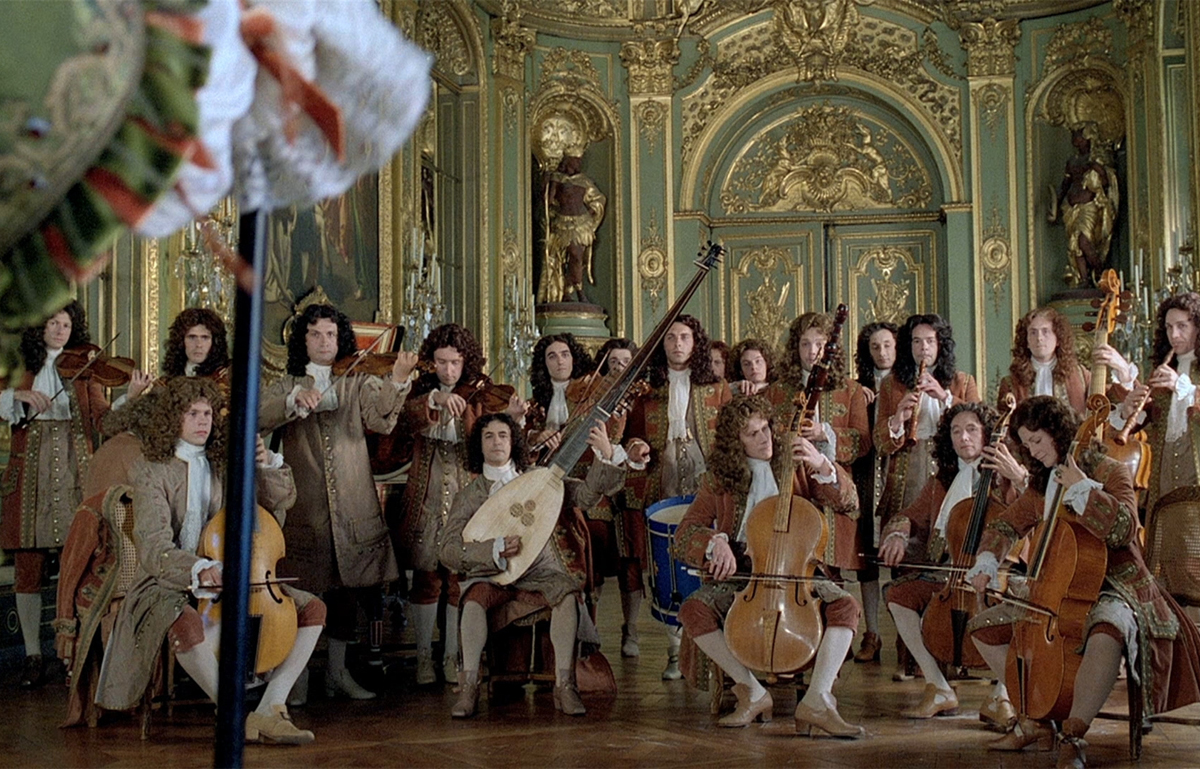A still image from the film Tour les Matins du Monde
Ever since Tafelmusik cellist Allen Whear began touring with us back in the mid-1990s, he has been the unofficial curator of movie entertainment while on the road. As a life-long movie buff and a professional musician, Allen soon realized how his two obsessions intersect in several ways.
Allen believes, for the most part, that movie soundtracks are meant to be subliminal—they are to guide your emotions and enhance the drama and action on screen without the viewer really noticing them. However, when it comes to hearing baroque music in film, he finds that it grabs his attention more than usual. Those who are in the field of period performance, or those who may be musically sensitive, might be particular about the music and its context in the film. Is the music appropriate to the period of the film? Is the performance in period style? Does the music enhance or distract from the film and viewer’s experience? Is it anachronistic?
He mused on these questions in a recent subscriber lecture on this topic. Below is a selection of excerpts from popular films that Allen showed during the lecture.
Barry Lyndon (1975)
Dir. Stanley Kubrick
Stanley Kubrick set a standard for period films in regards to lighting, costumes, make-up, and more. Similar to his 1968 film, 2001: A Space Odyssey, Kubrick used pre-recorded music by Bach, Vivaldi, Handel, and traditional tunes for this film.
Johann Sebastian Bach Concerto in C Minor, BWV 1060: II. Largo ovvero Adagio
Antonio Vivaldi Sonata no.5 in E Minor, RV 40
Farinelli (1995)
Dir. Gérard Corbiau
This film centers on the life and career of the 18th-century Italian opera singer Carlo Broschi, known as Farinelli, considered the greatest castrato singer of all time. The filmmakers decided to imagine what a castrato might sound like by fusing the vocal sounds of a soprano and a countertenor.
George Frideric Handel Lascia ch'io pianga
Jefferson in Paris (1995)
Dir. James Ivory
Jefferson in Paris is a semi-fictional account of Thomas Jefferson's tenure as the Ambassador of the United States to France before his presidency, and of his alleged relationships with British artist Maria Cosway and his slave, Sally Hemings. Jefferson was a great music lover, a violinist, and a fan of Corelli—we see and hear this in the first scene below. The second scene shows how audiences may have behaved during a live opera performance at the time.
Arcangelo Corelli Violin sonata op. 5, no. 12 “La Follia”
Antonio Sacchini Excerpt from Dardanus
Tous les Matins du Monde (1991)
Dir. Alain Corneau
This film has been credited with helping with the revival of the viola da gamba. The soundtrack was also so popular that it challenged pop artists, including Michael Jackson, for the top spot on the music charts. In the first scene, we see a young Marais auditioning to be the student of master gambist, Sieur de Sainte-Colombe. In the second scene, we see a much older Marias directing a large ensemble, providing a hint of what the orchestra in Louis XIV's court might have looked and sounded like in Versailles.
Marin Marais Improvisation on Sur Les Folies D'Espagne (excerpt)
Jean-Baptiste Lully Marche Pour La Cérémonie Des Turcs
Le Roi Danse (2000)
Dir. Gérard Corbiau
This film is based on Philippe Beaussant's 1992 biography of Jean-Baptiste Lully, Lully ou le musicien du soleil , and focuses on Lully's relationship with King Louis XIV. In this scene, we see Lully directing one of his operas with his eyes completely focused on the King. The beautiful sounds and lavish production values are worth the watch, and the soundtrack was recorded by Musica Antiqua Köln.
Lully "C'est lui dont les dieux ont fait choix" from Isis
The Madness of King George (1994)
Dir. Nicholas Hytner
Handel's music is used throughout the soundtrack of this film, and it's not necessarily a period ensemble but it's effectively used. In this comedic scene, the madness of King George III exposes itself while the orchesta attempts to play.
G.F. Handel Water Music
Mein Name ist Bach (2003)
Dir. Dominique de Rivaz
Composer Johann Sebastian Bach is introduced to King Frederick II of Prussia in 1747. In this short scene, we see a reimagined encounter between the two, where Bach tries to get the King, a flute player, to play along with him with unfortunate results.
Marie Antoinette (2006)
Dir. Sofia Coppola
This is a retelling of France's iconic but ill-fated queen, Marie Antoinette. Although this is a period film set in 18th-century France, the soundtrack features 1980s new wave and post-punk artists and music. Coppola still used appropriate baroque pieces throughout the film, including in this ball scene showing the characters dancing to music by Rameau.
Jean-Philippe Rameau Menuet from Les indes galantes
Casanova (2005)
Dir. Lasse Hallström
This romantic comedy is based on the life of Giacomo Casanova, set in Venice in 1750. The film’s soundtrack features a variety of Baroque composers including well known composers such as Vivaldi, Rameau, Corelli, and Handel, and lesser known composers such as Durante and Paisiello. Tafelmusik cellist Allen Whear, along with other Tafelmusik musicians, were involved with the recording of this soundtrack, from performing to providing input on period performance.
Leonardo Leo Cello Concerto no. 3 in D Minor
J.-P. Rameau Overture to Les Fêtes de Polymnie
Johan Helmich Roman Assagio no. 1 in G Minor
We hope you enjoyed this selection of baroque music in the movies, and embraced your inner Roger Ebert or Armond White.

